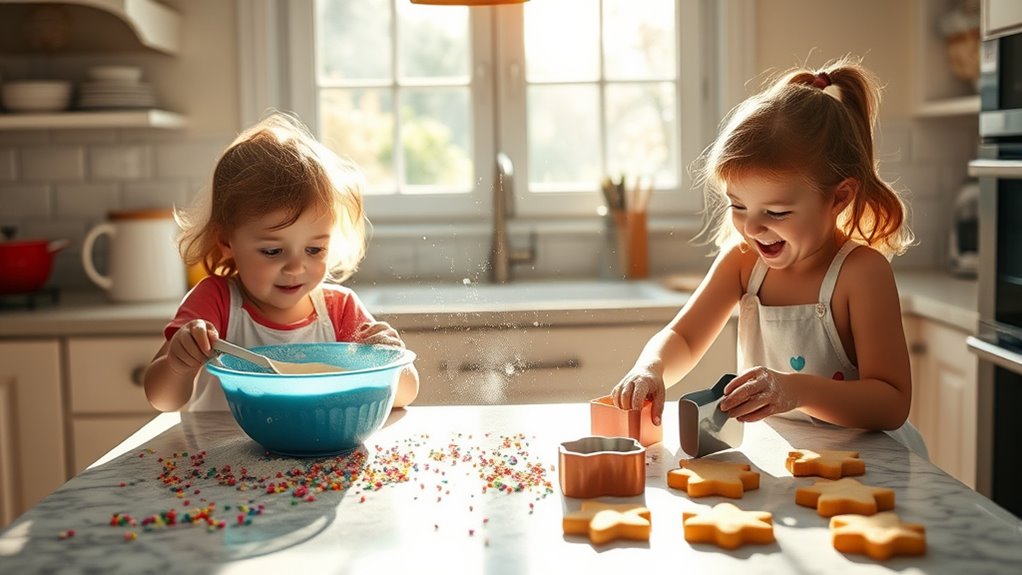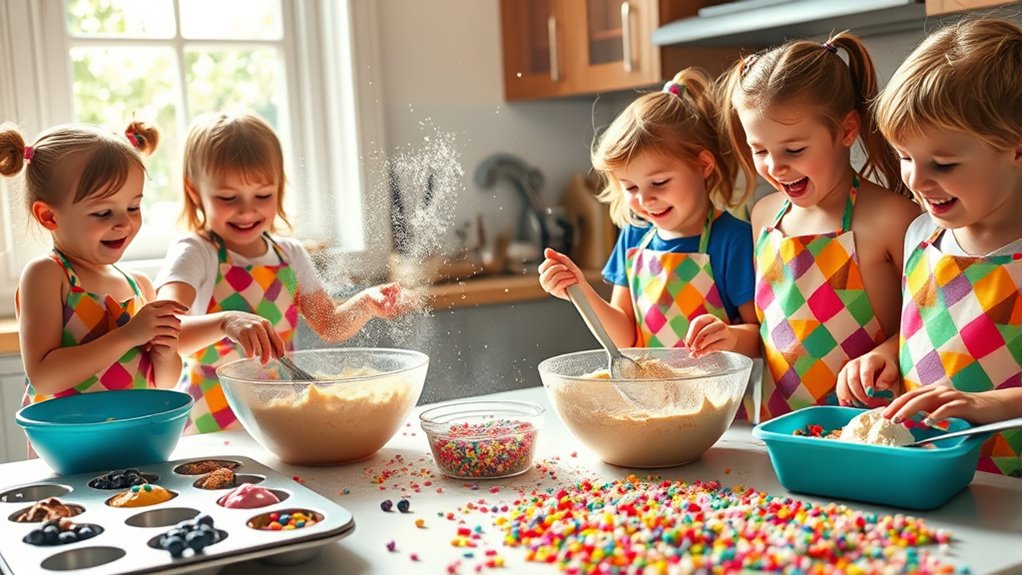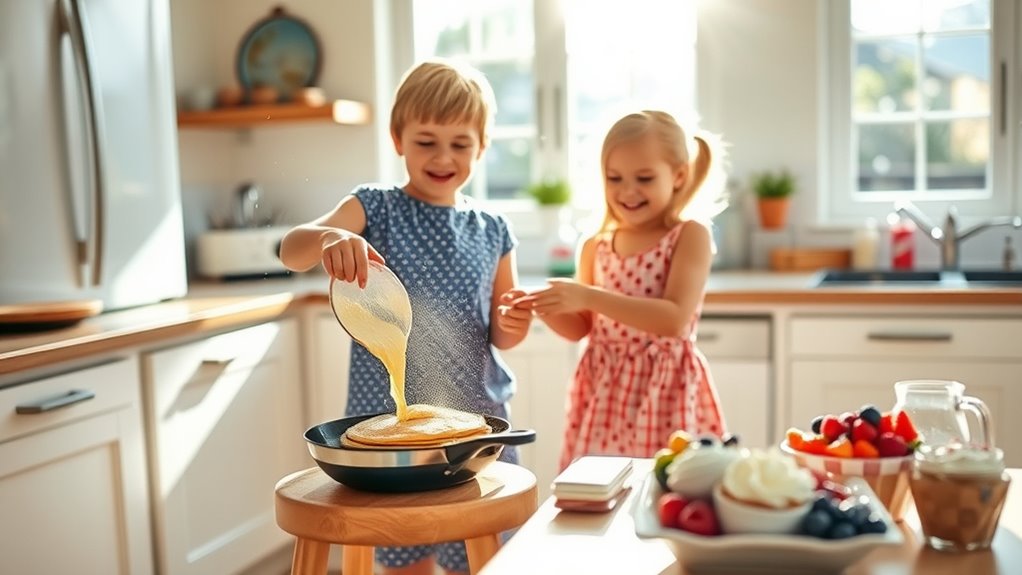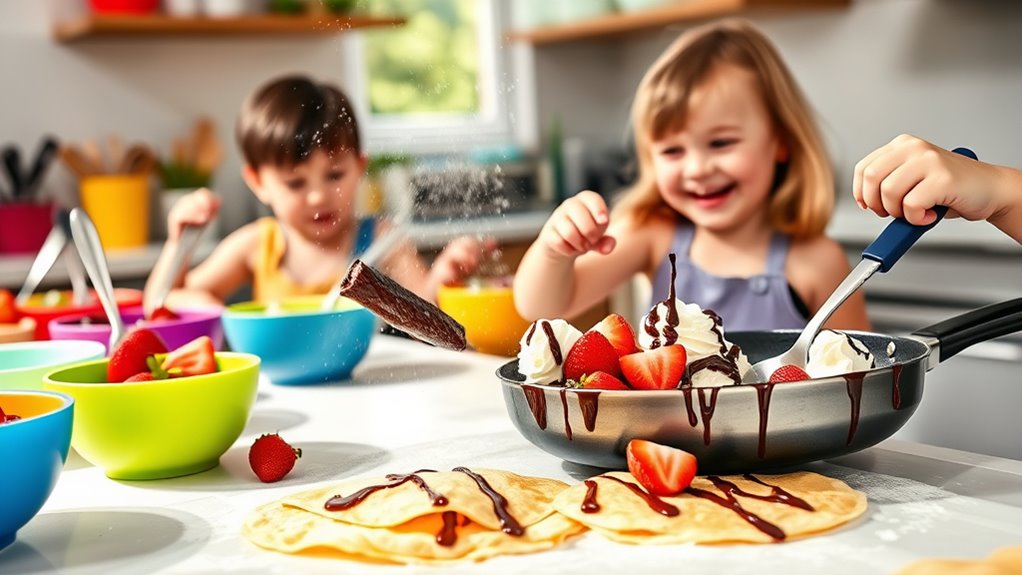Cooking and baking with kids is a fantastic way to bond while having fun! Try Muffin Mania with quick and tasty muffins in flavors like blueberry and banana oatmeal. Pancake Perfection lets you whip up fluffy pancakes with creative toppings. Don’t forget Cookie Decorating Fun, where kids can express their creativity with colorful sprinkles and icing. These activities not only make delicious treats but also teach valuable skills. There’s so much more to explore together in the kitchen!
Key Takeaways
- Engage kids with Muffin Mania, offering various flavors and healthy ingredient options for a fun baking experience in under 30 minutes.
- Create Pancake Perfection using simple ingredients and allow for creativity with shapes and unique toppings, enhancing breakfast fun.
- Enjoy Cookie Decorating Fun with sugar cookies, royal icing, and vibrant colors, promoting creativity and lasting memories through customization.
- Foster teamwork and problem-solving skills while cooking, transforming kitchen time into a valuable learning experience for children.
- Prioritize safety and organization in a kid-friendly kitchen, ensuring accessibility and cleanliness to encourage independent cooking adventures.
The Joy of Cooking Together

Cooking together can be a delightful experience that not only fills your home with delicious aromas but also strengthens your bond with your kids. As you measure ingredients, you’ll notice their math skills blossom through fractions and ratios. Discussing recipes boosts their literacy while introducing new vocabulary. Plus, the science behind cooking—like how yeast makes dough rise—sparks curiosity about the world. When things don’t go as planned, you’ll see their problem-solving skills develop. By involving them in meal planning, you teach them about nutrition and balanced diets. Incorporating chia seeds into your recipes can also add nutritional value and spark discussions about healthy eating habits. Chia seeds are high in fiber, promoting satiety and helping to reduce hunger. Additionally, cooking can enhance their culinary skills, setting a foundation for future independence in the kitchen. Including soluble fiber in your meals, such as from chia seeds, can further aid in promoting bowel regularity and digestive health.
Muffin Mania: Easy Recipes for Kids

Muffin mania offers a fantastic way to introduce kids to the joys of baking! With a variety of flavors like blueberry, chocolate chip, and banana oatmeal, there’s something for every taste.
Kids will love getting hands-on, measuring ingredients, and stirring the batter. Plus, muffins bake in under 30 minutes, making it a quick and fun project.
You can even sneak in healthy options like spinach banana or yogurt-based muffins, teaching kids about nutrition while they bake. Encourage creativity by letting them customize their muffins with fruits, nuts, or even a sprinkle of cinnamon-sugar topping. Additionally, consider incorporating whole grains into your recipes for added nutritional benefits.
This activity not only fosters culinary skills but also enhances math, science, and teamwork skills in a deliciously engaging way!
Pancake Perfection: Simple Breakfast Ideas

Whether you’re looking for a quick breakfast or a fun weekend activity, pancakes are a perfect choice for cooking with kids. You only need simple ingredients—flour, eggs, milk, baking powder, and salt. Incorporating low-carb vegetables like spinach into the batter can add nutritional value to your pancakes.
Pancakes make for a delightful breakfast or weekend activity with kids, using just a few simple ingredients.
For fluffy pancakes, mix the batter gently; a few lumps are okay. Melted butter adds richness, but feel free to use plant-based options. Cook on a preheated skillet to achieve that golden brown color and crispy edges.
Try banana pancakes for a nutritious twist, or make mini pancakes for little hands. Let kids get creative with animal shapes using squeeze bottles. You can also serve pancakes with a flavorful dumpling sauce for a unique breakfast experience.
Encourage them to add fruits, nuts, or even cheese for savory options. Enjoy the bonding time while developing their cooking skills!
Cookie Decorating Fun: Let Creativity Shine

There’s something magical about decorating cookies with kids that sparks creativity and joy. Start with sugar cookies—they’re perfect for decorating since they hold icing well.
Prepare royal icing in advance and gather your tools like squeeze bottles and toothpicks for detailed work. Choose a vibrant color palette with 3-4 gel food colors, including white, to make your designs pop.
Set up decorating stations with various sprinkles and edible decorations, encouraging kids to explore their imaginations. Use food coloring pens for quick designs and consider cookie templates to simplify the process.
Remember to contain the mess with paper plates or rimmed sheets. Most importantly, enjoy every moment; this experience builds life skills and creates lasting memories together!
Crepe Creations: A Deliciously Fun Activity

After the fun of cookie decorating, it’s time to explore another delightful culinary adventure: crepe making. This activity not only teaches kids valuable skills like using a blender and measuring ingredients, but it also emphasizes safety in the kitchen. Understanding kitchen safety practices is vital to ensure a secure cooking environment.
Mixing the batter is a simple task for little hands, while pouring it onto a hot skillet offers a chance to practice stovetop cooking.
Once the crepes are ready, let your creativity shine by filling them with fresh fruit, Nutella, or whipped cream. You can even try savory options like ham and cheese! Additionally, consider making a batch of sugar-free vanilla ice cream to serve alongside your crepes for a healthier dessert option.
With a few variations and tips, like refrigerating the batter for better consistency, you’ll create delicious memories together that everyone can enjoy.
Sweet Cinnamon Rolls: A Treat to Make Together

Making sweet cinnamon rolls together isn’t just about the delicious end result; it’s a fun and engaging way to bond with your kids in the kitchen.
Start by mixing warm water, sugar, and yeast to proof the yeast. Then, combine all-purpose flour, granulated sugar, and butter to create a smooth dough. Kids will love kneading until it’s elastic and watching it rise! Remember to keep the workspace clean, as hygiene practices are essential when baking with children.
Once it doubles in size, flatten the dough into a rectangle, sprinkle brown sugar and cinnamon for a sweet filling, and roll it up tightly. Cut into individual rolls and shape them into fun designs.
After a final rise, bake until golden brown, then drizzle with icing. Enjoy your tasty creations together! Remember, baking with kids also helps develop their fine motor skills as they measure and mix ingredients.
Kitchen Safety: Keeping Kids Safe While Cooking

When cooking with kids, ensuring their safety is a top priority that can’t be overlooked. Always supervise them in the kitchen; never leave children unattended, especially when they’re using sharp tools or heat sources.
Create a safe cooking space by keeping the area clutter-free and storing sharp objects out of reach. Teach proper hygiene, emphasizing handwashing and avoiding raw ingredients.
Equip kids with safe cooking skills, like using oven mitts and cutting boards. Discuss emergency preparedness, such as basic first aid and what to do in case of a fire.
Educational Benefits of Cooking With Kids

Cooking with kids offers a wealth of educational benefits that go beyond just preparing meals. It fosters independence as they learn to prepare their meals, while planning helps introduce budgeting and money management skills.
Following recipes teaches them the importance of sequence and accuracy, enhancing their math and reading abilities. As they observe chemical reactions during cooking, they’re engaging with science concepts in a fun way.
Following recipes not only enhances math and reading skills but also introduces kids to fun scientific concepts through cooking.
Collaborative cooking builds teamwork and boosts self-esteem, especially when they see tangible results. Plus, experimenting with ingredients encourages creativity and an appreciation for different flavors.
Ultimately, cooking empowers kids with practical life skills, nutritional awareness, and a sense of accomplishment, laying the foundation for self-sufficiency in adulthood.
Setting Up a Kid-Friendly Kitchen

Creating a kid-friendly kitchen involves thoughtful design and organization that prioritizes safety and accessibility. Start by switching to electric appliances to reduce fire hazards. Additionally, a well-organized kitchen can enhance focus and productivity for everyone involved in cooking. Incorporating smart shopping techniques can also help you find the best tools and gadgets for your kitchen.
Design cabinets and storage at lower levels so kids can easily access what they need. Choose easy-to-clean materials to manage messes, and incorporate a hidden trash bin to keep the space tidy. A cozy atmosphere with warm color palettes can also make the kitchen inviting for children.
Set up designated areas for children to work safely without interfering with cooking operations. Create central gathering spaces, like large kitchen islands, and provide easy-access snack storage to keep kids engaged.
Use labeled drawers to help them manage their belongings, and consider adding step stools to make countertops reachable. A well-organized kitchen enhances the cooking experience for everyone involved. Additionally, incorporating hooks for wall organization can help keep utensils and tools easily accessible for young chefs.
Developing Life Skills Through Cooking

As children immerse themselves in the world of cooking, they not only learn how to prepare meals but also develop essential life skills that will benefit them for years to come.
Cooking sharpens critical thinking and problem-solving abilities as they navigate recipes and troubleshoot mishaps. Following instructions boosts their memory and sequential thinking. Measuring ingredients introduces basic math concepts, while engaging their senses enhances cognitive growth. Regular outings to dog training classes can also improve their socialization skills, similar to how children benefit from teamwork in cooking. Additionally, learning to adapt recipes can mirror the process of overcoming heat pump failure challenges in real life. Understanding dog breeds and traits can also help children appreciate the importance of making informed choices, just like selecting the right ingredients for a dish.
Cooking enhances critical thinking and problem-solving skills, while also introducing basic math and boosting memory through engaging, hands-on learning experiences.
Planning meals fosters decision-making and organizational skills. Cooking together builds teamwork and communication, while cleaning up teaches responsibility.
Furthermore, understanding nutrition during cooking sessions helps them make healthier food choices. By mastering these skills, your child gains confidence and independence, laying the groundwork for a self-sufficient future. Furthermore, the process of cooking encourages creative practice, allowing children to explore their imagination and express themselves through food.
Frequently Asked Questions
What Age Is Appropriate to Start Cooking With Kids?
You can start cooking with kids as early as 18 months. At this age, they can help wash vegetables and mash soft foods.
As they grow, from ages 3 to 5, they can stir, pour, and even set the table.
By 6 to 8, they can follow simple recipes and learn basic knife skills.
From ages 9 to 12, kids can work more independently, tackling complex recipes and developing their culinary confidence.
How Can I Make Cooking More Engaging for Picky Eaters?
To make cooking more engaging for picky eaters, involve them in the process. Let them choose recipes or ingredients they’re curious about, and assign fun tasks like washing veggies or mixing.
Create a relaxed kitchen atmosphere to ease pressure and encourage exploration. Try theme nights, interactive meals, or sensory activities that spark their interest.
Present food in colorful, playful ways, and share stories about the dishes to create a positive connection with what they eat.
What Should I Do if a Recipe Doesn’T Turn Out?
If a recipe doesn’t turn out, don’t stress! Start by identifying what went wrong—maybe the measurements were off or it cooked too long.
Adjust the ingredient ratios or try a different method next time. Gather feedback from others who’ve had success with the recipe, and embrace the learning experience.
Can Cooking Help Improve My Child’s Math Skills?
Yes, cooking can definitely help improve your child’s math skills!
When you measure ingredients, you’re teaching fractions and ratios in a practical way. As you cut and shape food, they explore geometry and spatial relationships.
Following recipes involves sequencing, which reinforces logical thinking. Plus, cooking together fosters teamwork and communication, enhancing problem-solving abilities.
Through these activities, your child gains confidence and sees math as a valuable life skill they can apply every day.
How Do I Store Leftovers Safely After Cooking With Kids?
Storing leftovers is like tucking treasures away in a chest, ensuring they stay fresh for future feasts.
After cooking, refrigerate your leftovers within two hours to keep them safe from unwanted bacteria. Use airtight containers to guard against spoilage, and separate large portions for quicker cooling.
Label each container with the date, so you know when to enjoy your culinary creations again.
Conclusion
Cooking and baking with kids not only creates lasting memories but also fosters essential life skills. Did you know that children who help in the kitchen are 40% more likely to develop healthy eating habits later in life? By making these fun recipes together, you’re not just teaching them how to whip up delicious treats; you’re also instilling confidence and creativity. So, roll up your sleeves, gather your ingredients, and enjoy the delightful journey of cooking together!









